Recipe, pages 222-223.
When I was growing up in Oregon, my brother and I couldn’t wait for autumn each year. We had an old oak tree in the backyard, which — to an eight-year-old — looked like about a billion feet high. My father, on the other hand, did not look forward to it. He had an adversarial relationship with the tree. Sure it is was old. Tall. Beautiful. A provider of cool shade for those rare summer occasions when it was craved.
But then there were the leaves. The leaves. The thousands of leaves shed each year like some persnickety Himalayan in summer. His nemesis. Anyway, we’d wait until Dad had raked most of the leaves into a huge pile. You know what I’m gonna say now, don’t you? We’d wait until he wasn’t looking and jump in the pile. Messed everything up.
“For crimony’s sake!” he’d yell, and we’d run.
Back then, he’d just burn the leaves. It seemed everyone in town did the same. Each autumn before the snows there would be that smoky aroma, totally recognizable, winding through the valley air. A sure sign of autumn.
This Alinea recipe does that. Brings you back to memories of autumn. It’s a combination of wild upland game, sweet apple cider, and smoky forest aromas. Deep fried on a stick. But better than any fried stick food you’ll ever get at the County Fair, that’s for sure.
It’s subtle. Many city folk may not get it. Especially if you’re a Southern Californian, where the scrub oaks have only two colors: green, and dead.
And if you burn anything in your backyard other than a steak, the local first-responders will have you spread eagle on the burmuda in a heartbeat.

Pheasant
There are several backcountry shooting ranches here in San Diego, where I’ve been told, you can tap a pheasant. I guess it’s good exercise. I learned that you can’t shoot fowl from the comfort of your own car. Inconvenient for some Californians.
I told my friend Jo about this. “Well you know Martin,” she responded. “They wouldn’t have come up with that rule if people hadn’t tried it!” So true. They also have different start dates for crossbow and shotgun lovers. Crossbow on a pheasant? Now that’s meat on a stick.
Locavore or not, I didn’t want to go to that extreme for this recipe. So I got a whole Van Vooren 3-pound pheasant from the friendly local butchers at Iowa Meat Farms. There are several other sources here in San Diego: restaurant providers Hamilton Meat, and locally-centric Homegrown Meats in La Jolla, to name two. Thanks, Donna, for the resources!
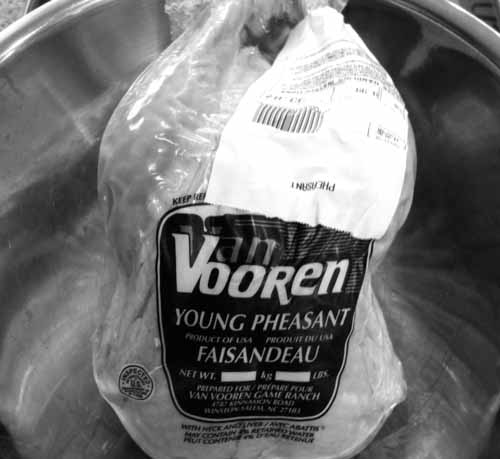
For this dish, I’m going to cook both breasts en sous vide, an experiment with butter vs. duck fat.
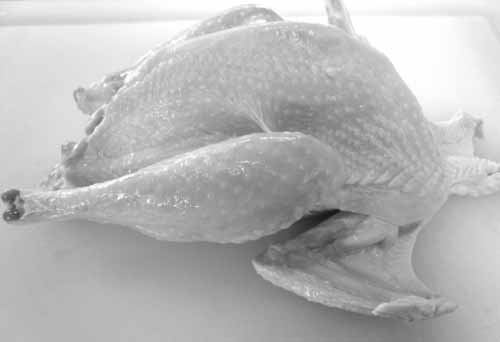
I allayed the pheasant, reserving the breast. With the other meat, skin and bones I made a p(h)easant stew of onions, carrots, celery, some leftover turkey stock from Thanksgiving, sage, rosemary and bay.

Oh, the book says to reserve the breast “with skin on.” Oops. I’d already messed that up when deboning the bird. So I just kinda swaddled them with the skins.

Mise en place:
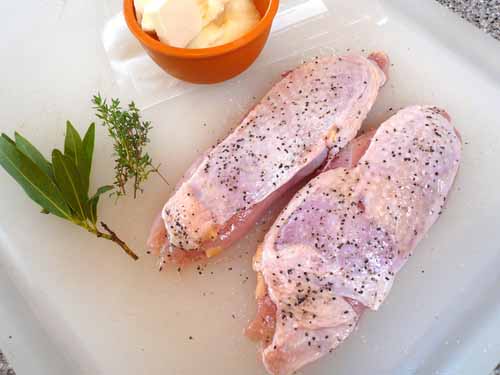
I seasoned the pheasant with salt and pepper.
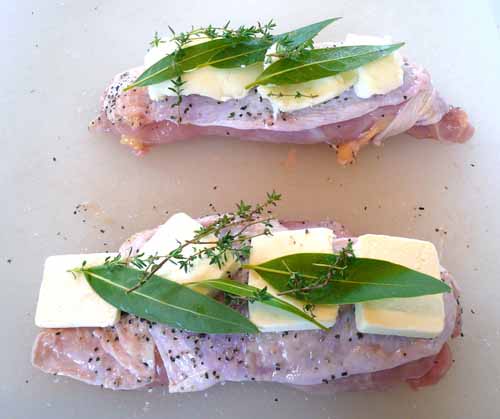
I put each breast in a small vacuum bag with bay leaves and fresh thyme, and sealed it up with my FoodSaver on the normal, dry setting. I like a lot of spices, so I “increased the dosage.” In one bag I added the butter, in another the duck fat. We’ll taste how they compare.
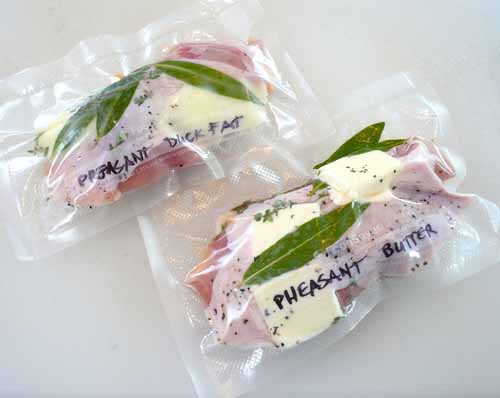
I cooked each in a pot of water at 160ºF for about 20-25 minutes, then cooled them in an icewater bath.
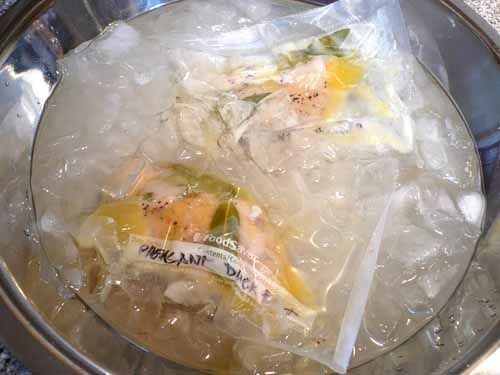
Removed the breasts from the bags (and added the leftover spices and fat to my simmering stew). Trimmed into 0.75-inch cubes. Each breast yielded about eight cubes. Saved in a plastic container, covered with a damp paper towel.
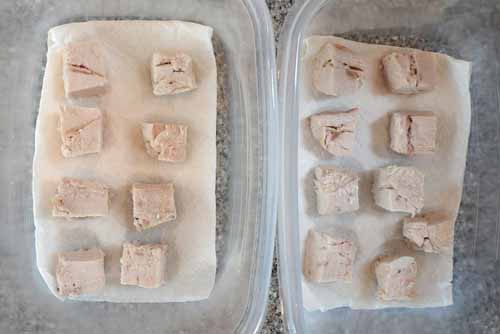
The results? They were both good and very tender. But the pheasant cooked in butter tasted better to me. I guess “butter is better,” eh?
Ingredients:
Pheasant breast, from Iowa Meat Farms
Springs fresh thyme, from my garden
Organic bay leaves
Challenge butter
Duck fat, from Hudson Valley Foie Gras
Diamond Cyrstal kosher salt and fresh ground pepper to taste
Cider Gel
I peeled, cored and diced the apples into one-inch pieces. Mise en place:

Added the cider, salt and agar in a small saucepan, brought to a boil, and then simmered for about 15 minutes.

The liquid thickens and foams up a bit, so watch it carefully, stirring, until the apples are very tender.
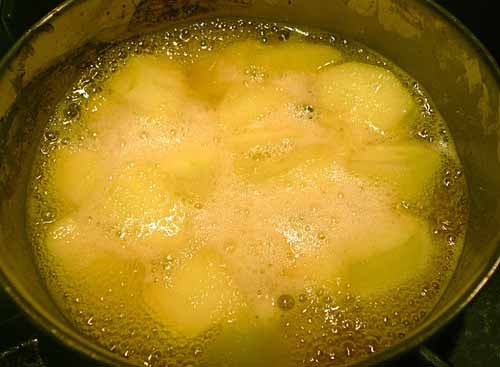
Blended the hot mixture until smooth, securing the top (with a towel to prevent volcanic surprises).

The book says to use a 4.5 x 6 inch tray, but you can use anything that will bring the height of the liquid to about 0.75 inch.

I sprayed a shallow ceramic tray with non-stick oil, wiped off the excess, and strained the thickening liquid gel into it.

Then refrigerated until set.
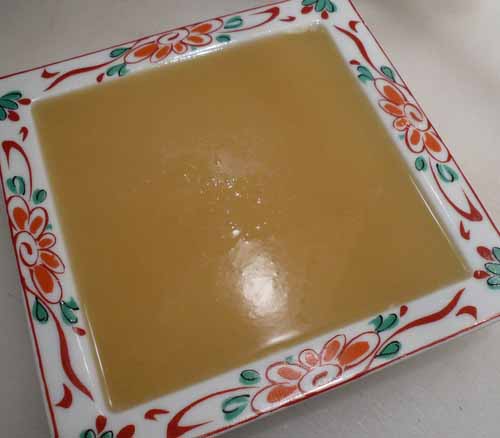
Cut up into 0.75-inch cubes and refrigerate.
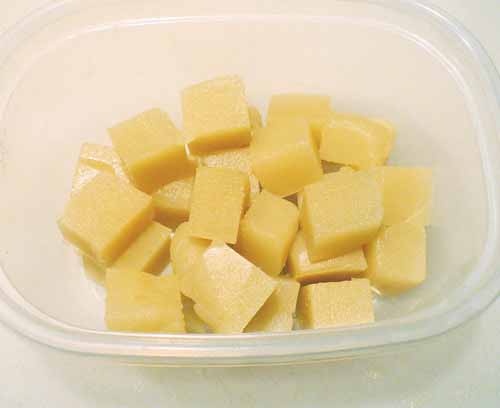
Ingredients:
Granny Smith apples
Martinelli’s apple cider
Diamond Crystal kosher salt
Agar agar
Shallots
I used “regular” shallots because my local sources did not have any “grays.” In fact, when you go to a regular grocery store they look at you like “Huh?” when you ask for them.
Once, I even had to explain what a shallot was. “Shallot? How you spell ‘shallot?’ We have scallions.”
No, it’s not what I’m looking for.
What’s a gray shallot?
There are two types of shallot (Allium cepa ascalonicum) generally available today: grey and “Jersey” pink.A gray shallot is simply the type favored by French chefs for it’s stronger flavor. You can substitute any shallot you’ll find at your local grocer.
Mise en place:
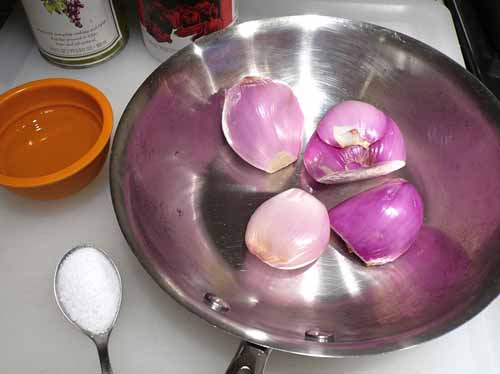
Anyway, I tossed the shallots with grape seed oil (which I actually had on-hand) and kosher salt. You’re not supposed to peel them before you bake them. But I can’t help it. Is that a compulsion, or force of habit?
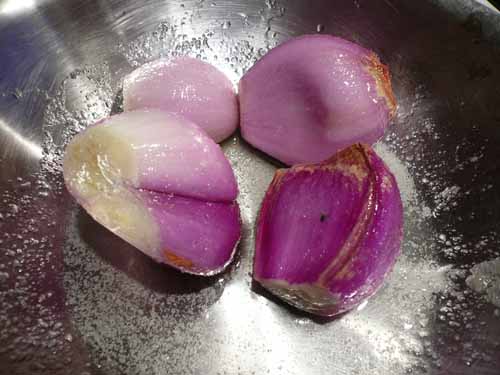
Then baked in a 350ºF oven until they were very, very soft, about an hour.
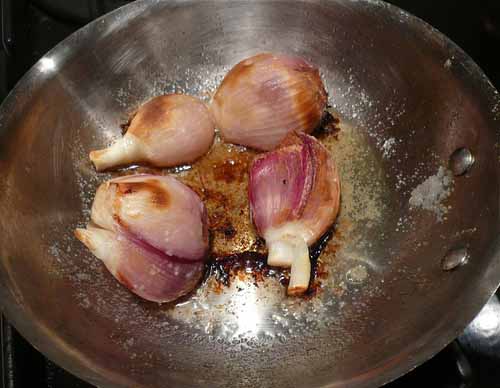
Now you’re supposed to peel, and cut the shallots up into 0.75-inch cubes. I did the best I could.
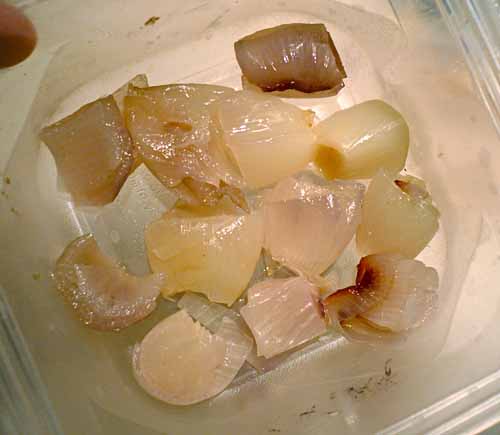
Ingredients:
Jersey shallots
Grape seed oil
Diamond Crystal kosher salt
Dry Tempura Base
I mixed the flour, baking powder and cornstarch together in a stainless steel bowl.
Ingredients:
Gold Medal all-purpose flour
Baking Powder
Kingford’s corn starch
To Assemble and Serve
Mise en place:
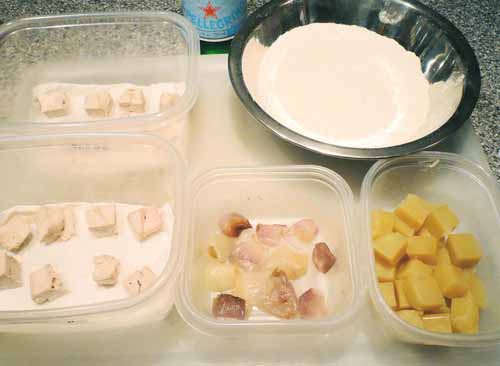
Errata: When you do these, make sure to use the corrections from the Errata Page, and they’ll turn out perfectly.
I whisked together 225g of the dry tempura base with the sparkling water.
Driving around San Diego, I finally found some fall foliage. Although not oak, these red sweetgum (Liquidambar styraciflua) trees will do. I picked some branches, the very ends with buds and new growth. Make sure they still have the turning leaves attached. Also, if you’re going to transport them for a while, place them in some water (or better yet — half water, half glycerin) so they don’t dry out. The last thing you want is for the leaves to fall off just as you place the dishes down in front of your guests.
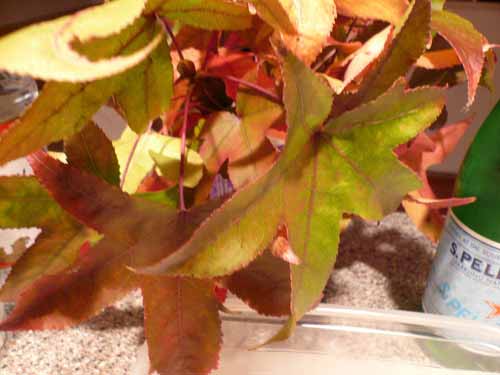
I rinsed each off very carefully and let dry. With a vegetable peeler, I removed about 2 inches of soft bark from each branch, making skewers for the pheasant, cider gel and shallot cubes.
I skewered a cube of shallot, then cider gel, and finally pheasant with each branch.

Dredged in flour then the tempura batter. Tapping off excess.

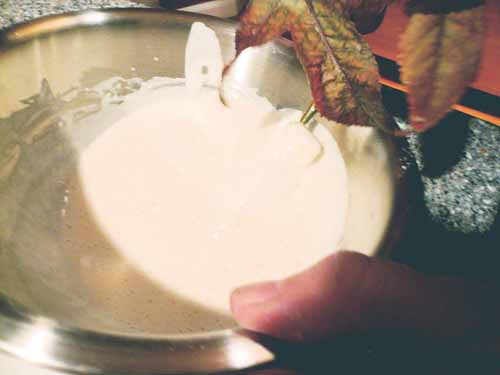
Then stuck it in 375ºF hot oil and fried until lightly golden. Careful of those fingers. It gets a bit dicey so close to the hot oil, which spatters all over, including on the leaves. Which is good. You can take a paper towel with oil and wipe them down. Makes for shiny presentation. I do this with birds of paradise from my yard all the time.

Then I drained them on paper towels and added salt and pepper to taste.
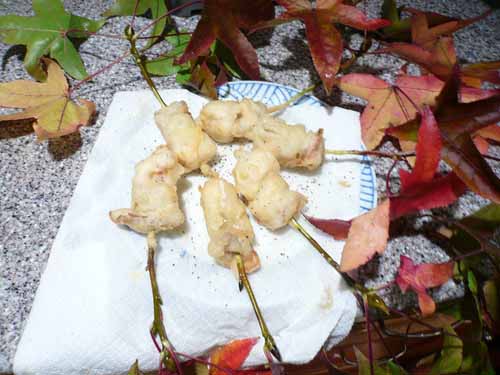
Placed in my own “squid” holder. Alinea uses these, designed by Martin Kastner at Crucial Detail. Available at J.B. Prince. Trivet sold separately. I made mine from a broken wire whisk I had on-hand. Just took some wire cutters and pliers to the thing, and voila!

Ingredients:
Very cold Pellegrino water
Gold Medal all-purpose flour
Diamond Crystal kosher salt and fresh ground pepper to taste
Peanut oil for frying
Fresh oak branch ends with leaves intact
Serveware:
Squid wire serving piece, by Crucial Detail, from J.B. Prince
or
wire whisk
needle-nosed pliers
wire cutter
Equipment
Salter digital scale
Measuring bowls
Kitchen knife, pairing knife, cutting board
Stainless mixing bowl
FoodSaver vacuum sealer and bags
Immersion circulator, or large pot with thermometer
Osterizer blender
Deep fryer, or large pan with thermometer
Small saucepan
Wire whisk
Plastic wrap
Plastic containers
Yields: 1 breast, 8 servings. 2 breasts, about 16.
7 Responses to PHEASANT, Cider, Shallot, Oak